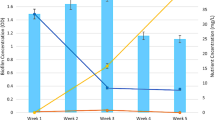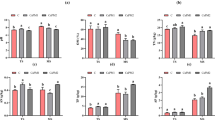Abstract.
The co-immobilization and the culture of anaerobic and aerobic communities was tested for the mineralization of 2,4,6-trichlorophenol (2,4,6-TCP). At first, the anaerobic microorganisms (aggregated into granules) were cultivated in an upflow anaerobic sludge blanket (UASB) reactor, in a continuous mode, with glucose, propionate, acetate (COD loading rate = 0.5–2.0 g COD/l per day, ratio 1:1:1) and 2,4,6-TCP (2,4,6-TCP loading rate = 25–278 µmol/l per day) as substrates. 2,4,6-TCP was degraded into 2,4-DCP and 4-CP, but it was not mineralized because of the low degradation rates of 4-CP. Furthermore, the highest loading rates of 2,4,6-TCP (>126 µmol/l per day) caused the inhibition of the strains degrading the propionate. The granules were therefore tested in association with the aerobic community. They were immobilized in κ-carrageenan/gelatin [2% (w/w) of each polymer] gel beads and cultivated in a reactor, on their own (to test the influence of the gel), and then with the aerobic community, under anaerobic and air-limited conditions, respectively. The results showed that (1) the gel did not influence the activity of the granules, (2) the anaerobic and aerobic communities could be easily co-immobilized in gel beads and cultivated in a reactor, (3) the mineralization of 2,4,6-TCP (2,4,6-TCP loading rate = 10–506 µmol/l per day), its intermediates of degradation and the other substrates [glucose + acetate + propionate (ratio 1:1:1) = COD loading rate = 500 mg COD/l per day] could be obtained under air-limited conditions if the culture parameters were strictly controlled [airflow = 36–48 vvd (volume of air/volume of liquid in the reactor per day), pH value at around 7.5]. Finally, the gel did not retain its structure during the whole culture (263 days) in the air-limited reactor, but the anaerobic and aerobic communities retained their activities and worked together for the mineralization.
Similar content being viewed by others
Author information
Authors and Affiliations
Additional information
Received revision: 8 November 2000
Electronic Publication
Rights and permissions
About this article
Cite this article
Gardin, .H., Lebeault, .J. & Pauss, .A. Degradation of 2,4,6-trichlorophenol (2,4,6-TCP) by co-immobilization of anaerobic and aerobic microbial communities in an upflow reactor under air-limited conditions. Appl Microbiol Biotechnol 56, 524–530 (2001). https://doi.org/10.1007/s002530000577
Received:
Accepted:
Issue Date:
DOI: https://doi.org/10.1007/s002530000577




